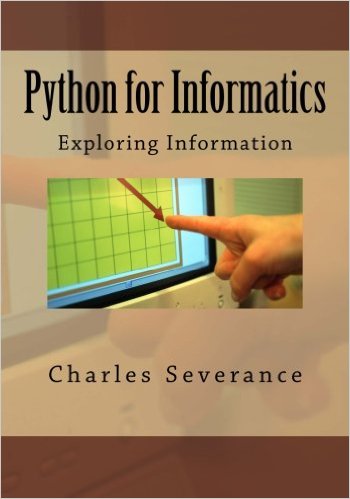
Python for Informatics: Exploring Information
A remix of Allen B. Downey's Think Python, the overall book structure has been changed to get to doing data analysis problems as quickly as possible and have a series of running examples and exercises about data analysis from the very beginning.
Publication date: 02 Sep 2013
ISBN-10: 1492339245
ISBN-13: 9781492339243
Paperback: 244 pages
Views: 21,509
Type: Book
Publisher: CreateSpace Independent Publishing Platform
License: Creative Commons Attribution-ShareAlike 3.0 Unported
Post time: 13 Jan 2011 09:48:30
Python for Informatics: Exploring Information
 A remix of Allen B. Downey's Think Python, the overall book structure has been changed to get to doing data analysis problems as quickly as possible and have a series of running examples and exercises about data analysis from the very beginning.
A remix of Allen B. Downey's Think Python, the overall book structure has been changed to get to doing data analysis problems as quickly as possible and have a series of running examples and exercises about data analysis from the very beginning.
Publication date: 02 Sep 2013
ISBN-10: 1492339245
ISBN-13: 9781492339243
Paperback: 244 pages
Views: 21,509
Document Type: Book
Publisher: CreateSpace Independent Publishing Platform
License: Creative Commons Attribution-ShareAlike 3.0 Unported
Post time: 13 Jan 2011 09:48:30
Share — copy and redistribute the material in any medium or format
Adapt — remix, transform, and build upon the material for any purpose, even commercially.
The licensor cannot revoke these freedoms as long as you follow the license terms.
Click here to read the full license.
Charles Severance wrote:The first 10 chapters are similar to the Think Python book but there have been some changes. Nearly all number-oriented exercises have been replaced with data-oriented exercises.
Topics are presented in the order to needed to build increasingly sophisticated data analysis solutions. Some topics like try and catch are pulled forward and presented as part of the chapter on conditionals while other concepts like functions are left until they are needed to handle program complexity rather introduced as an early lesson in abstraction. The word "recursion" does not appear in the book at all.
In chapters 11-14, nearly all of the material is brand new, focusing on real-world uses and simple examples of Python for data analysis including automating tasks on your computer, retrieving data across the network, scraping web pages for data, using web services, parsing XML data, and creating and using databases using Structured Query Language.
The ultimate goal of all of these changes is a shift from a Computer Science to an Informatics focus is to only include topics into a first technology class that can be applied even if one chooses not to become a professional programmer.
Students who find this book interesting and want to further explore should look at Allen B. Downey's Think Python book. Because there is a lot of overlap between the two books, students will quickly pick up skills in the additional areas of computing in general and computational thinking that are covered in Think Python. And given that the books have a similar writing style and at times have identical text and examples, you should be able to move quickly through Think Python with a minimum of effort.
Tweet
About The Author(s)
Charles Severance (@drchuck) is a Clinical Associate Professor in the School of Information at the University of Michigan where he teaches Informatics courses; he has also taught Computer Science at Michigan State University. Previously he was the Executive Director of the Sakai Foundation and the Chief Architect of the Sakai Project (www.sakaiproject.org).

Charles Severance (@drchuck) is a Clinical Associate Professor in the School of Information at the University of Michigan where he teaches Informatics courses; he has also taught Computer Science at Michigan State University. Previously he was the Executive Director of the Sakai Foundation and the Chief Architect of the Sakai Project (www.sakaiproject.org).